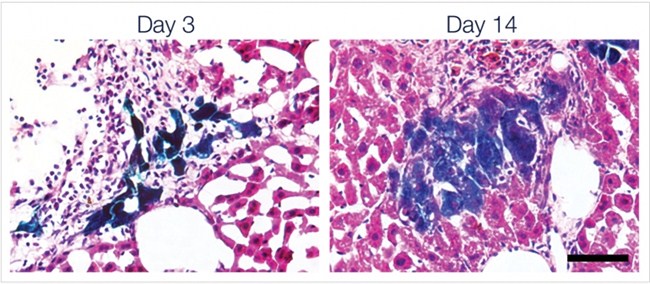Tammy Chang and Boris Rubinsky Develop Novel Surgical Technique for Restoring Failing Organs

UCSF News Reports on a novel surgical approach to transplanting cells into diseased organs developed by Tammy T. Chang, MD, PhD, a gastrointestinal and acute care surgeon and principal investigator in the The Chang Laboratory for Liver Tissue Engineering, and Boris Rubinsky, PhD, Professor Emeritus of Bioengineering at UC Berkeley. The technique is called irreversible electroporation, or IRE, and enables newly transplanted clusters of liver cells, or hepatocytes to thrive and proliferate in a mouse liver.
The research, reported in the May issue of the journal BioTechniques, could one day lead to a minimally invasive stem cell transplantation procedure to restore function to diseased livers and other organs.
By piercing liver cells with rapid pulses of electricity, scientists at UC San Francisco have demonstrated an entirely new way to transplant cells into organs to treat disease.
Because the technique provides a hospitable environment for newly introduced cells, it may dramatically boost survival of stem cells transplanted to restore a failing liver, heart or lungs, and may one day ease the critical shortage of donor organs, the researchers said. Findings from a mouse study appear in the journal BioTechniques, publishing May 15, 2017.
Success of stem cell treatments largely depends on how well the new cells survive and proliferate in the target region. But the authors said that establishing a thriving population of new cells in host organs remains difficult.
“Our research is in its early stage,” said Tammy T. Chang, MD, PhD, assistant professor in the UCSF Department of Surgery and the paper’s lead author. “We’ve shown we can create the hospitable environment for new cells. Full demonstration of the procedure’s value will be when we can introduce stem cells to restore function to diseased livers and other organs.”
A major barrier to efficient cell transplantation has been the failure to provide space for new cells to take hold inside a diseased host organ such as a liver, Chang said noting that non-functional cells block newly transplanted cells from becoming established. Chang has led the effort to develop and test the new procedure that first clears away host cells to make room for transplanted cells.

Transplanted hepatocytes, shown in blue, three and 14 days after treatment, demonstrating successful integration into the host liver. Image courtesy of Tammy T. Chang
Read full article at UCSF News - Novel Surgical Technique Paves Way to Restoring Failing Organs
The Chang Laboratory for Liver Tissue Engineering
Using non-thermal irreversible electroporation to create an in vivo niche for exogenous cell engraftment, Tammy T. Chang, Vivian X. Zhou, and Boris Rubinsky, BioTechniques, Vol. 62, No. 5, May 2017, pp. 229–231, doi 10.2144/000114547